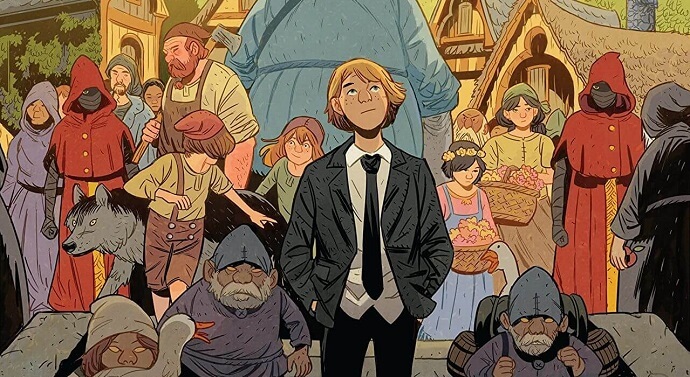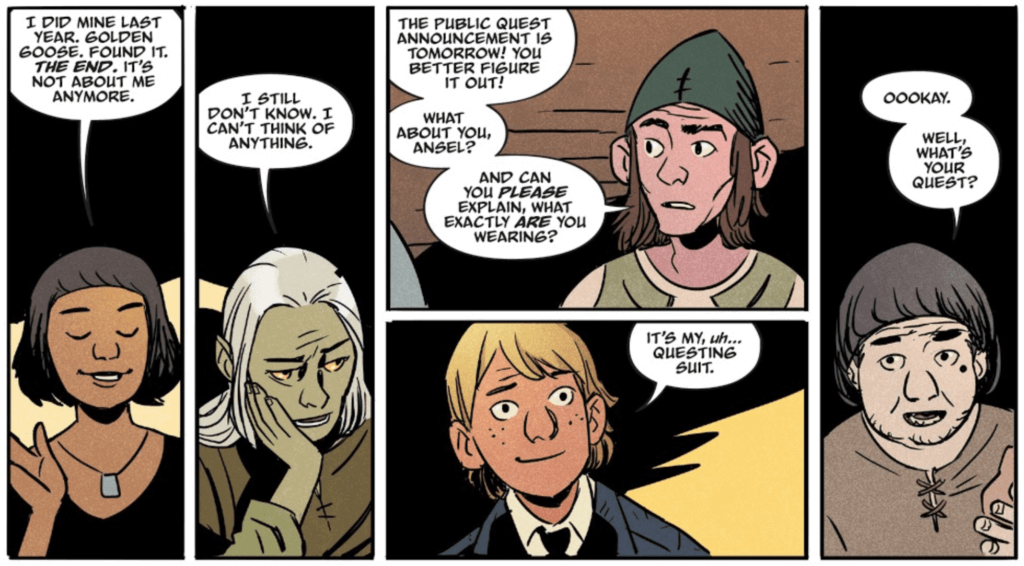Folklords #1
Jim Campbell (letterer), Matt Kindt (writer), Chris O’Halloran (colorist), and Matt Smith (artist)
BOOM! Studios
November 13, 2019
“Once upon a time… / No… Just this one time.” Right from the jump, Folklords sets out to deconstruct the fantasy genre through the story in which its suit-and-tie wearing protagonist, Ansel, is coming of age.
Ansel, we’re told by the narrator—represented by letterer Jim Campbell as text approximating handwriting on boxes approximating parchment—doesn’t belong. On top of showing Ansel’s out-of-his-world wardrobe and mechanical gadgets, as artist Matt Smith and colorist Chris O’Halloran do, writer Matt Kindt’s script tells us that Ansel does not belong to his setting. Neither the time period nor the location are named, but the mise-en-scène suggests somewhere on a continent like Europe, centuries in our world’s past. Then there’s his curiosity. There isn’t all that much worldbuilding in this first issue (of five). The creative team expects the reader to be at least passingly familiar with the Western fantasy genre, citing Harry Potter and The Chronicles of Narnia in the solicit. However, I’m not convinced that the white male lead of an American fantasy series that only credits women for design elements can really be all that different.
Unlike Charles, the blind troll who mans a ferry service for Ansel’s village, Ansel can freely enter the tree house tavern where the reader is introduced to Ansel’s supporting cast: Demure (also known as “Dee”), a human girl, and Archer, an elf (as evidenced by pointed ears) with a green tinted complexion. O’Halloran’s colors balance shifts between the cool, blue tones of the night and the warm, red tones of the fire lit tavern and the village in daylight, but the near homogeneity of the human characters’ complexions suggests that this is a series that is going to approach race through a binary fantasy paradigm of humans (and near humans, like elves and potentially dwarves) and monsters (like Charles).
At the tavern, Ansel declares that for his impending quest, which in his village signals a shift from adolescence to adulthood, he is going to find the titular Folklords. Smith’s artwork following the declaration made me feel as though I could hear a pin drop. Throughout the comic, his work with O’Halloran was most effective for me when it was evocative of sound (or its absence). Shortly afterwards, the apparent antagonists are named: the Librarians.
Before the reader can be properly introduced to them, Ansel shares his motivation for seeking out the Folklords. He’s been having visions of another world—ostensibly our world, or at least a world that looks like one that the reader may be more familiar with—a world that O’Halloran deftly colors in blues. It is a world with typewriters and wristwatches, gas masks and prisons, airplanes and skyscrapers, cars and guns. “In this other world,” Ansel says to Dee, “There are buildings as tall as mountains. There are ships that fly through the air. Carriages that move without horses,” and then, “I think this place is real. I think I can actually get there. And I think the Folklords know the way.”
The influence of a book like The Lion, the Witch, and the Wardrobe is most apparent here, in the promise of another world. Ansel is in a place like Narnia, looking for a wardrobe to climb through. Dee accuses him of being greedy. Ansel is Folklords’s Edmund Pevensie. He’s after forbidden knowledge (the Turkish delight was a metaphor, Folklords is less confectionery).
That knowledge is protected by the Librarians. The Librarians don red cloaks over bandage-wrapped torsos and heads, one eye open and the other closed. During the ceremony in which Ansel, Archer, and their cohort of not-yet-adults declare their quests, the Librarians intercede at the invocation of the Folklords. One explains, “It is our sworn duty to guard you against all dangers. This includes dangerous … ideas,” then, “This is why knowledge of … or even the pursuit of knowledge of the Folklords or any other fictional narratives is expressly forbidden!”
Ansel decides to embark on his quest in spite of the authoritarian Librarians, taking Archer along with him, although I have little doubt that Dee will reappear in future issues. They’re off to prove that the Folklords are real and write themselves into legend, but not before the issue’s final panel reveals the narrator’s hand.
Folklords has a compelling premise, flipping certain parts of the fantasy genre on their head, but I’m not sure that it’ll stick the landing. Kindt, Smith, O’Halloran, and Campbell work well together, but I’m not convinced that they’re going to be able to deliver on the promise of the series—that it might subvert the genre—because I know how fantasy works, and knowledge is a curse.





